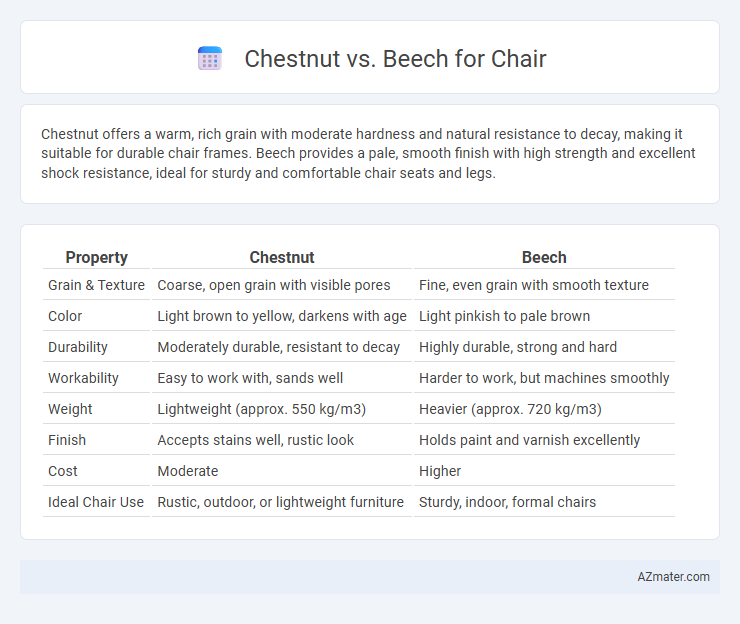Chestnut offers a warm, rich grain with moderate hardness and natural resistance to decay, making it suitable for durable chair frames. Beech provides a pale, smooth finish with high strength and excellent shock resistance, ideal for sturdy and comfortable chair seats and legs.
Table of Comparison
| Property | Chestnut | Beech |
|---|---|---|
| Grain & Texture | Coarse, open grain with visible pores | Fine, even grain with smooth texture |
| Color | Light brown to yellow, darkens with age | Light pinkish to pale brown |
| Durability | Moderately durable, resistant to decay | Highly durable, strong and hard |
| Workability | Easy to work with, sands well | Harder to work, but machines smoothly |
| Weight | Lightweight (approx. 550 kg/m3) | Heavier (approx. 720 kg/m3) |
| Finish | Accepts stains well, rustic look | Holds paint and varnish excellently |
| Cost | Moderate | Higher |
| Ideal Chair Use | Rustic, outdoor, or lightweight furniture | Sturdy, indoor, formal chairs |
Introduction to Chestnut and Beech Woods
Chestnut wood is valued for its durability, straight grain, and warm color, making it a popular choice for rustic and traditional chair designs. Beech wood features a fine, uniform texture with excellent strength and shock resistance, often used in modern and minimalist chair construction. Both woods offer sustainable options with distinct aesthetic and structural qualities suited to various furniture styles.
Wood Characteristics: Chestnut vs Beech
Chestnut wood is lightweight with a coarse grain and excellent resistance to decay, making it suitable for outdoor chairs, while beech wood is dense, hard, and exhibits a fine, uniform texture ideal for durable indoor furniture. Chestnut's natural durability and moderate workability contrast with beech's superior strength and smooth finish, offering enhanced stability in chair construction. The choice between chestnut and beech hinges on desired chair aesthetics, longevity, and environmental exposure.
Durability and Longevity Comparison
Chestnut wood offers moderate durability and longevity, characterized by its moderate hardness and resistance to decay, making it suitable for indoor furniture like chairs. Beech wood is known for its exceptional hardness, strength, and resistance to wear, providing superior durability and long-lasting performance in high-use chair applications. Overall, beech outperforms chestnut in terms of structural integrity and lifespan, ensuring chairs maintain stability and appearance over extended periods.
Aesthetic Differences in Grain and Color
Chestnut wood showcases a prominent, coarse grain with warm golden to reddish-brown hues, creating a rustic and inviting aesthetic ideal for traditional chair designs. Beech wood offers a fine, uniform grain pattern with a pale cream to light reddish-brown color, giving chairs a sleek, smooth, and modern appearance. The contrasting grain textures and color tones make chestnut suited for earthy, textured decor, while beech complements minimalist, contemporary interiors.
Workability and Ease of Crafting
Chestnut wood offers excellent workability with its straight grain and moderate hardness, making it easier to cut, shape, and sand during chair crafting. Beech wood, known for its fine, tight grain and hardness, provides superior strength but requires more effort to machine and finish, often needing sharper tools for precise detailing. For chair construction, chestnut's ease of crafting suits intricate designs, while beech ensures robust durability despite its tougher working process.
Comfort and Ergonomics in Chair Making
Chestnut wood offers a softer texture and moderate flexibility, enhancing comfort through gentle cushioning in chair seats and ergonomics by adapting slightly to body contours. Beech wood provides superior hardness and durability, supporting ergonomic design with firm, stable seating that maintains posture alignment over extended use. Both woods contribute unique comfort properties; chestnut excels in slight give and warmth, while beech ensures structural support and longevity in ergonomic chair construction.
Environmental Impact and Sustainability
Chestnut wood offers a renewable and biodegradable option for chair construction, sourced from fast-growing trees that require minimal chemical treatment, resulting in a lower carbon footprint compared to many hardwoods. Beech wood, while durable and commonly used in furniture, often involves more intensive processing and slower tree growth rates, which can increase its environmental impact due to higher resource consumption and longer regeneration cycles. Choosing chestnut supports sustainable forestry practices through its quicker growth and natural resistance to pests, making it a more eco-friendly choice for environmentally conscious consumers.
Cost and Market Availability
Chestnut wood generally offers a more affordable option compared to beech, making it popular for budget-friendly chair production. Beech wood is widely available and favored for its hardness and durability but tends to be more expensive due to higher demand in the furniture market. Market availability for both woods varies regionally, with chestnut often more accessible in Europe and beech commonly sourced globally, influencing price fluctuations.
Best Uses: Chestnut or Beech for Chairs?
Chestnut wood offers a warm, rustic aesthetic with moderate hardness, making it ideal for traditional or decorative chairs that benefit from its rich grain and durability. Beech wood is harder and more shock-resistant, providing excellent strength and fine, even texture suited for modern, high-traffic seating requiring long-lasting wear and smooth finishes. For chairs demanding robustness and smooth shaping, beech is preferred, while chestnut suits designs favoring natural beauty and moderate strength.
Final Verdict: Choosing the Right Wood for Your Chair
Chestnut offers a warm, durable option for chairs with a distinctive grain pattern and moderate hardness, making it suitable for both rustic and elegant designs. Beech provides excellent strength and smooth texture, favored for its resistance to denting and ease of finishing, ideal for modern and traditional chair styles. The final verdict depends on chair use and aesthetics: chestnut suits those seeking natural beauty and moderate resilience, while beech fits users prioritizing durability and a sleek finish.

Infographic: Chestnut vs Beech for Chair
 azmater.com
azmater.com